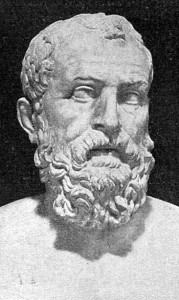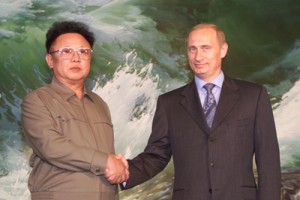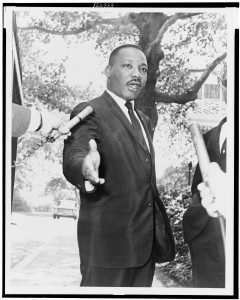Septuagenarian Romanian inventor Justin Capra has designed seven unconventional flying machines, including a jetpack.
You are currently browsing the yearly archive for 2011.
Tags: Justin Capra
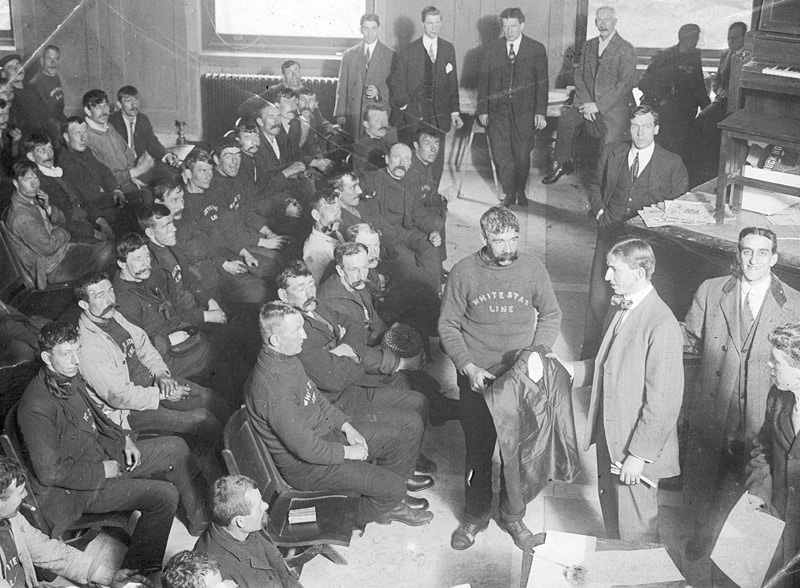
Surviving "Titanic" crew members wear warm, dry clothes that read "White Star Line," which was the name of the shipping company that owned the sunken vessel.
Even though it was women and children first into the lifeboats during the sinking of the Titanic, some crew members did survive the infamous meeting of steel and ice. The 1912 image above, from the International News Service, shows surviving crew members who had been transported to New York City wearing warm, dry clothes they had just been given. An excerpt about the Titanic‘s tragic maiden voyage from the New York Times article, “Biggest Liner Plunges to the Bottom at 2:20 A.M.“:
“The White Star liner Olympic reports by wireless this evening that the Cunarder Carpathia reached, at daybreak this morning, the position from which wireless calls for help were sent out last night by the Titanic after her collision with an iceberg. The Carpathia found only the lifeboats and the wreckage of what had been the biggest steamship afloat.
The Titanic had foundered at about 2:20 A.M., in latitude 41:16 north and longitude 50:14 west…all her boats are accounted for and about 655 souls have been saved of the crew and passengers, most of the latter presumably women and children.
There were about 2,100 persons aboard the Titanic.“
Trying to get rid of 25$
Hi all, I’m a 22 year old athlete and I have in my possession 25 dollars, I would like to get rid of it, but I want something awesome in return. So please tell me what you’d be willing to trade my 25 dollars for.
Thanks all, and nothing illegal or disgusting.
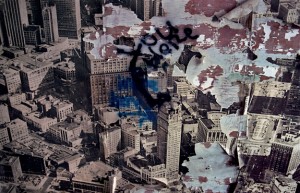
"Red Dawn 2" recently filmed in Detroit, not needing to dress down it's buildings to make is seem the site of a devestating invasion. (Image by Yves Marchan and Romain Meffre.)
Are we fascinated by the modern ruins of Detroit because they seem otherworldy or because they seem like our future?
The Motor City, shattered by financial apocalypse, has become the popular subject of ruinsploitation books and articles and photo series. Some urban analysts believe that’s because because we subconsciously fear Detroit is a harbinger of what lies ahead for us all. It seems melodramatic, but a good article by John Patrick Leary in Guernica wonders about that very idea. (Thanks Essayist.) An excerpt:
“For media workers from more prosperous cities, Detroit’s spaces of ruination appear to tell a history, or at least evoke a vague sense of historical pathos, absent in those other, wealthier cities. Indeed, one of the notable features of this Detroit boom is the fact that few of the people driving it actually live here. For someone from New York, Paris, or San Francisco, history seems more visible here, and this is the visual fascination that Detroit holds. As [Yves] Marchand and [Romain] Meffre write on their website, ‘Ruins are the visible symbols and landmarks of our societies and their changes, small pieces of history in suspension.’ In a country perennially plagued with a historical amnesia, ruins are rare permanent reminders of a history unsuited to the war memorials and equestrian statues that dot the national landscape. Another reason for the fascination with Detroit’s decline is less about history, though, and more about the future.
Coleman Young, Detroit’s charismatic and still-controversial mayor during the years of the city’s most precipitous decline in the nineteen seventies and eighties, put it well in his fascinating 1994 autobiography, Hard Stuff: ‘Detroit today,’ he wrote, ‘is your town tomorrow.’ From the 1967 riots, when Detroit became the flashpoint of the country’s political and racial crisis, to the deindustrialization and crime of the nineteen seventies and the nineteen eighties, the city has been a bellwether of each major urban crisis since World War II. Today, Detroit, to use an overused but appropriate metaphor given the city’s scarred appearance, is ‘ground zero” of the collapse of the finance and real estate economy in America. Detroit has been hit as hard as any city by the foreclosure crisis and by unemployment, and so it embodies the looming jobless future, or more precisely, our worst fears about that future.”

From dust jacket flap: "This book is a tribute to some of America's greatest characters, people holding on to unique ways of life at all costs."
When I recently put up a post about Harvey Wang, it reminded me that in my whole life in New York City, I have only been the victim of theft one time and the stolen item was an excellent 1996 book called Holding On: Dreamers, Visionaries, Eccentrics and Other American Heroes, which Wang co-created with David Isay. I believe my house painter nicked it several years back when I left him alone in the apartment for a couple of hours.
The book, about eccentric Americans (snake handlers, coon-dog graveyard caretakers, hat blockers, burlesque museum curators, etc.) who aren’t willing to be swallowed whole by a homogenized culture, is definitely worth stealing, though I paid a few bucks for a replacement copy. An excerpt from the chapter, “Donald Bean, Proprietor, Dinosaur Gardens, Moscow Texas”:
“‘I Thought I Saw a Dinosaur’ reads the welcome sign to Moscow, Texas, an unincorporated hamlet ninety miles north of Houston. There isn’t much more to the place. Indeed, the number of dinosaurs residing in Moscow rivals the town’s population, all thanks to the retired carpenter named Donald Bean.
‘I try to keep this as much as I can like it would have been back then, you know,’ Bean explains as we begin our tour through the roadside attraction. Canned dinosaur sound effects erupt from small speakers hidden in trees. We round the corner and come upon the theme park’s first dinosaur–Elasmosaurus, a twenty-foot-long flippered beast residing in a murky bog of water, surrounded by a ring of pond scum. ‘If you cleaned it out,’ Bean explained, ‘it wouldn’t be a swamp.’
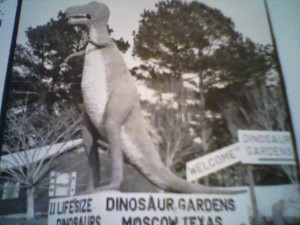 All told, Donald Bean’s roadside attraction consists of exactly eleven worn fiberglass dinosaurs laid out along a winding trail cut into the woods behind his home. Bean opened up Dinosaur Gardens in 1981–the culmination of a lifelong fascination with these prehistoric creatures. ‘I always liked dinosaurs. They’re large…they’re big, and they ruled the world for years…Thousands of years…Well, millions of years!’ Donald Bean came up with the idea for the theme park in the late 1950s when he happened upon a similar roadside attraction in Oregon while vacationing with his wife, Yvonne. ‘Soon as I saw that I said, ‘That’s what I want to do!’ So I did it’
All told, Donald Bean’s roadside attraction consists of exactly eleven worn fiberglass dinosaurs laid out along a winding trail cut into the woods behind his home. Bean opened up Dinosaur Gardens in 1981–the culmination of a lifelong fascination with these prehistoric creatures. ‘I always liked dinosaurs. They’re large…they’re big, and they ruled the world for years…Thousands of years…Well, millions of years!’ Donald Bean came up with the idea for the theme park in the late 1950s when he happened upon a similar roadside attraction in Oregon while vacationing with his wife, Yvonne. ‘Soon as I saw that I said, ‘That’s what I want to do!’ So I did it’
It took Bean twenty years of planning and saving before he was finally ready to build his own theme park. ‘My wife wasn’t too for the idea right off the jump go, because we spent our life savings on it.’ The park cost the Beans $100,000 to build, and when Dinosaur Gardens opened it was met with just about the level of enthusiasm one might anticipate for a dinosaur theme park in the heart of Moscow, Texas. The masses did not seem to share Bean’s fervor for creatures prehistoric. There were no lines at the ticket office. It kind of disappointed me,’ Bean says, wiping a spider web from Struthiomimus‘s mouth. ‘I don’t know how many people I thought would come, but I thought there’d be quite a few.'”
Tags: David Isay, Donald Bean, Harvey Wang
–
Spider-Man would appear to be the biggest dingus of the lot.

"Jobs was being Jobs: He was telling the truth, he was simplifying the truth, he was exaggerating the truth, he was leaving part of the truth out." (Image by acaben.)
Tom Junod’s 2008 profile about Steve Jobs in Esquire becomes an even better read now for very unfortunate reasons. (Thanks Longform.) The article’s opening:
“One day, Steve Jobs is going to die.
First, he is mortal. Second, the odds against him are not only actuarial — the inevitable odds we all face — they are clinical. Four years ago, he announced in a memo to his employees that he had undergone surgery, that the surgery was for the removal of a malignant tumor, that the tumor was on his pancreas, and that the surgery was, as he put it, successful. An exceptional man who specializes in exceptionalizing himself — he has been an economic force for thirty years, and it’s still hard to put him in a category, or even to say exactly what he does — he responded to his disease by exceptionalizing it as well. He was at pains to say that the pancreatic cancer he had was not that kind of pancreatic cancer — not the kind that kills you, without much room for exception, in six months or so — but rather ‘a very rare form of pancreatic cancer… which represents about 1 percent of the total cases…each year, and can be cured by surgical removal.’ Even in extremis, Jobs was being Jobs: He was telling the truth, he was simplifying the truth, he was exaggerating the truth, he was leaving part of the truth out. It is true that his cancer, originating not in the ductwork of the pancreas but rather in the islets of Langerhans, is slow growing and, in the words of one expert, can be addressed ‘with curative intent’; it is also true that even after surgery, the average patient lives about five years.”
Tags: Steve Jobs, Tom Junod
This is sad. Let’s hope he gets some help. (Thanks Reddit.)
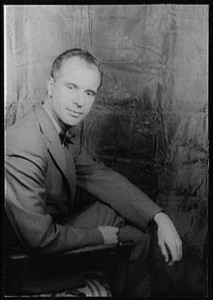
Hersey wrote an aftermath to "Hiroshima" 40 years later, tracing the fates of the six survivors he originally interviewed. (Photo by Carl Van Vechten.)
Truman Capote’s In Cold Blood and John Hersey’s Hiroshima are the two best pieces of long-form American nonfiction I have ever read. I wouldn’t change a word of either one. Hersey’s work, which he wrote for his longtime employer, The New Yorker, was so brilliantly shattering that the entire August 31, 1946 issue was dedicated solely to the article. It became an instant classic and so did the subsequent book version.
Although he was always best know for this piece during his life, Hersey turned out a formidable quantity of other quality fiction and nonfiction. A 1989 Vintage collection, Life Sketches: Incisive and Profoundly Insightful Portraits of Extraordinary Men and Women, 1944-1989, brought together some of Hersey’s finest biographical articles.
The 1945 piece, “The Brilliant Jughead,” tells the story of Private John Daniel Ramey, an illiterate U.S. soldier who was sent to a special training unit in Pennsylvania that conducted a highly successful three-month basic literacy course. This unit, and others like it, taught more than a quarter million illiterate servicemen–who were labeled with the pejorative “jughead” by some fellow soldiers–to read and write during WWII. An excerpt:
“Private Ramey, who was assigned to the Pennsylvania school toward the end of March, 1945, could hardly be called a typical jughead. There is, in fact, no typical illiterate, any more than there is a typical college graduate. Ramey is above whatever average there is. He finished the course, which usually takes twelve weeks, in ten. By jughead standards, Ramey is brilliant. He says that he was often embarrassed, when he was a civilian, by not being able to read and write, but the surprising thing about his life before the war is how much he, an illiterate, was able to do for himself: at one time he owned a house, ran a small coal mine employing twenty-eight men, and had two automobiles, the better of which was a Mercury with, as he says, ‘one of them cloth tops on it,’ bought brand-new. The fact that he is above average makes him especially grateful for the opportunities, the amazements, opened up for him by being educated, for the first time in his life, to the written word.”

"A gravedigger was arrested...on the charge of stealing potatoes out of the lot." (Image by Viktor Vasnetsov.)
Gravediggers stealing potatoes is a problem that still plagues us today, but it was positively rampant in 1900, as is evidenced by this article from the December 29, 1900 issue of the Brooklyn Daily Eagle. An excerpt:
“A week ago John Miskofsky, 27 tears old, of 126 Vienna avenue, a gravedigger, was arrested on the complaint of Theodore Paltz of Hegeman and William avenues, on the charge of stealing potatoes out of the lot. After the first arraignment Miskofsky was paroled, but failed to appear in court on the day set for the examination. Magistrate Worth then instructed Court Officer Albert N. Shuttleworth to arrest him. Yesterday the officer went to Miskofsky’s home and was told by his wife that he was at work in the Evergreen Cemetery. Shuttleworth went, as directed, to the cemetery, and finally located his man at the bottom of a grave that he was digging. He was placed under arrest and was locked up in the Ralph avenue station.
Miskofsky told the officer that he had paid Paltz $1.35 for the potatoes and thought he would not have to return to the court. The officer so explained the case to Magistrate Teale this morning in the Gates avenue court, where the prisoner was again arraigned, but he was held for examination until Wednesday, and went to jail in default of $200 bail.”
Tags: Court Officer Albert N. Shuttleworth, John Miskofsky, Magistrate Teale, Magistrate Worth, Theodore Paltz
Vital experiment conducted by Bioastronautics Research.
Made in the wake of the chaos theory entering into public consciousnes, Errol Morris’ unorthodox 1997 documentary focuses on a quartet of men in disparate professions–a wild-animal trainer, a topiary gardener, a mole-rat specialist and a roboticist–trying in their own way to do what the chaos theorists were also attempting to accomplish–find the underlying sense of unity in ostensible disorder.
Gardener George Mendonςa uses his hedge clippers to transform bushes into leafy elephants, giraffes and bears. These painstaking creations take years to grow and can be undone by one severe rainstorm or snowfall. “You’re fighting the elements,” he says, “trying to get them to do what you want them to do. It’s a constant battle.” Also battling is zoologist Raymond A. Mendez, who puzzles over how to create a secure captivity for African mole-rats, whose teeth can chew through concrete. MIT robot scientist Rodney Brooks has to somehow make machines obey his wishes, realizing that every success he enjoys may be helping silicon-based life eventually supplant carbon-based humans.
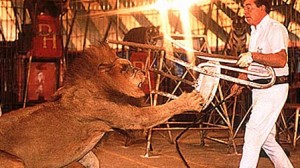 While these three men eagerly face their challenges and are largely willing to embrace the future, lion trainer Dave Hoover isn’t quite so cheerful about the the old guard being lost in the shuffle of new ideas: The chaos he faces isn’t only that unpredictable, maned creature in the cage with him, but also a more sophisticated world that isn’t quite so awed by a traveling circus. He pines for his mentor, Clyde Beatty, the legendary animal trainer, and the simpler days when the big top was greeted with a sense of wonder because people weren’t as connected to information and one another. Hoover knows that the accepted order has been undone, disproved and abandoned, to never return. New order, if it exists, must be discovered, and it may never be as grand.•
While these three men eagerly face their challenges and are largely willing to embrace the future, lion trainer Dave Hoover isn’t quite so cheerful about the the old guard being lost in the shuffle of new ideas: The chaos he faces isn’t only that unpredictable, maned creature in the cage with him, but also a more sophisticated world that isn’t quite so awed by a traveling circus. He pines for his mentor, Clyde Beatty, the legendary animal trainer, and the simpler days when the big top was greeted with a sense of wonder because people weren’t as connected to information and one another. Hoover knows that the accepted order has been undone, disproved and abandoned, to never return. New order, if it exists, must be discovered, and it may never be as grand.•
Tags: Dave Hoover, Errol Morris, George Mendonςa, Raymond A Mendez, Rodney Brooks
Mentally ill despot Kim Jong-il has pretty much ruined North Korea and its people with totalitarianism, human-rights violations and asinine economic policies. But he figures one good way to raise capital is to hold an international golf tournament. It would probably be wise for players to remain on the course at all times. A report from an Australian news service:
“The proposed tournament will be held in April at a golf course west of the capital Pyongyang, where the dictator Kim Jong-il supposedly sank 11 holes-in-one during a single round.
The cash-strapped communist state is inviting foreign amateur players to take part, charging them $1,000 for the five-day tour.
The golf course has not seen a round played since South Korea suspended cross-border tours nearly two years ago, after a North Korean soldier shot dead a Seoul housewife who had strayed into a restricted zone.”
Tags: Kim Jong-il

Crowd gathers in Times Square on October 12, 1920 to hear play-by-play of the World Series between the Brooklyn Dodgers and the Cleveland Indians.
I would have thought that the Black Sox scandal, in which several members of the Chicago White Sox accepted bribes to throw the 1919 World Series, would have dampened enthusiasm for the 1920 World Series. After all, it was in September of 1920 that some of the Sox admitted to a grand jury that they had participated in the fix. But based on this photo taken in Times Square during the ’20 World Series between the Brooklyn Dodgers and the Cleveland Indians, fans were still very into the National Pastime. People came together in the pre-radio age to hear play-by-play coverage of the Fall Classic outside of the New York Times building.
The Dodgers, who were often referred to as the Robins in those days and had previously been known as the Bridegrooms, were defeated by the Indians five games to two in the best-of-nine series. The team’s rabid fan base remained loyal until after the 1957 season, when the Dodgers, rather than moving to Queens as Robert Moses wished, instead decamped to Los Angeles.
Tags: Robert Moses
Bunny rabbits…they hop among us!

"She has spent some 15 years since that day studying this emerging breed of 'sociable robots.'" (Image by jeanbaptisteparis.)
Sherry Turkle fell in love with a robot once. It didn’t work out.
Turkle is the MIT professor whose 1995 book, Life on the Screen, was sanguine about the growing interaction between people and technology. But she had doubts after feeling her emotions stir for a robot named Cog she was working with at the university. The personal connection with the bot gave Turkle pause, making her wary that humans are growing reliant on gadgets not just for utility but also for the type of nourishment provided in the past by people.
While her love for Cog may say more about the academic herself than anyone else, Turkle doesn’t think so. She shared some of her fears of how artificial intelligence may soon replace human emotion with Jeffrey R. Young of the Chronicle. (Thanks A&L Daily.) An excerpt:
“She has spent some 15 years since that day studying this emerging breed of ‘sociable robots’—including toys like Furbies and new robotic pets for the elderly—and what she considers their seductive and potentially dangerous powers. She argues that robotics’ growing trend toward creating machines that act as if they were alive could lead people to place machines in roles she thinks only humans should occupy.
Her prediction: Companies will soon sell robots designed to baby-sit children, replace workers in nursing homes, and serve as companions for people with disabilities. All of which to Turkle is demeaning, ‘transgressive,’ and damaging to our collective sense of humanity. It’s not that she’s against robots as helpers—building cars, vacuuming floors, and helping to bathe the sick are one thing. She’s concerned about robots that want to be buddies, ‘implicitly promising an emotional connection they can never deliver.”
Tags: Jeffrey R. Young, Sherry Turkle
From Martin Luther King, Jr.’s 1965 Playboy interview:
“PLAYBOY: You categorically reject violence as a tactical technique for social change. Can it not be argued, however, that violence, historically, has effected massive and sometimes constructive social change in some countries?
MARTIN LUTHER KING: I’d be the first to say that some historical victories have been won by violence; the U.S. Revolution is certainly one of the foremost. But the Negro revolution is seeking integration, not independence. Those fighting for independence have the purpose to drive out the oppressors. But here in America, we’ve got to live together. We’ve got to find a way to reconcile ourselves to living in community, one group with the other. The struggle of the Negro in America, to be successful, must be waged with resolute efforts, but efforts that are kept strictly within the framework of our democratic society. This means reaching, educating and moving large enough groups of people of both races to stir the conscience of the nation.”
Tags: Martin Luther King Jr
Before the Sony Walkman and long before the iPod, the Astraltune was a personal music system, which was marketed to skiers who wanted some tunes on the slopes. It was the very first portable stereo cassette player, but the company somehow never patented the invention. The Finest Daily includes the Astraltune in a new list of firsts from the annals of gadgetry. (Thanks to justabuzz.) An excerpt:
“Most people think Sony’s Walkman paved the way to hearing loss for a generation of teenagers, but the original portable music player actually pre-dated the Walkman by almost five years. The Astraltune Stereopack debuted in Reno, Nevada in 1975 and it was aimed at freestyle skiers who wanted to groove out to their favorite tunes while hitting the slopes. It was a bulky 3-pound unit worn in a sack mounted on the chest, but it was the first time you had a power source, a cassette player and a headphone output in the same unit. The story doesn’t have a happy end though – the inventor(s) never patented their invention and today very few people remember it; Sony went on to dominate the personal stereo market for well over 15 years.”

"I'm not sure what to offer in return except a loving home for your dummy." (Image by Roy Erickson.)
Wanted: Free Ventriloquist Dummy
Hey everyone,
I’m on the look out for anyone offering to give away their ventriloquist dummy, condition isn’t that important as long as his mouth and eye functions still work, in fact, he can be a she. I’m also interested in free puppets but only if they are quality and not just some child’s stuffed animal. I’m not sure what to offer in return except a loving home for your dummy. Dummies from homes with pets are ok and so are dummies from smokers. If you happen to have a ventriloquist dummy that needs a good home please let me know, I’d be more than happy to come pick him up.
Thanks in advance!
From the February 2, 1867 Brooklyn Daily Eagle:
“California is troubled occasionally with slight shocks of earthquakes, but, as yet, has sustained no serious damage therefrom.
That of October, 1865, the most severe ever known, even by the oldest inhabitant, was in San Francisco, the cause of great alarm and some slight destruction of property. However, such a shock as that of 1865, may not occur again for a thousand years.”
Dr. Sidney Cohen is the one dispensing LSD to a patient in this 1950s video that was made at the Los Angeles Veterans Administration Hospital. *Thanks Reddit.) A decade later, in “Psychotherapy with LSD: Pro and Con,” Cohen was still largely singing the praises of acid. An excerpt:
“At a 1965 LSD conference Dr. Sidney Cohen, an American authority on LSD, summed up the claims made for LSD and LSD-like drugs by psychiatrists:
1. They reduce the patient’s defensiveness and allow repressed memories and conflictual material to come forth. The recall of these events is improved and the reaction is intense.
2. The emerging material is better understood because the patient sees the conflict as a visual image or in vivid visual symbols. It is accepted without being overwhelming because the detached state of awareness makes the emerging guilt feelings less devastating.
3. The patient feels closer to the therapist and it is easier for him to express his irrational feelings.
4. Alertness is not impaired and insights are retained after the drug has worn off.
Under skilled treatment procedures, the hallucinogens do seem to produce these effects and one more which is not often mentioned. That is a marked heightening of the patient’s suggestibility. Put in another way, the judgmental attitude of the patient toward the experience itself is diminished. This can be helpful, for insights are accepted without reservations and seem much more valid than under nondrug conditions.”
Tags: Dr. Sidney Cohen
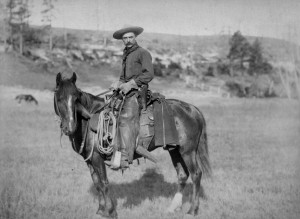
"The trouble started when the cowboy endeavored to help himself to a quantity of peanuts which he refused to pay for."
In 1902, if you mixed cowboys, Indians, Cossacks and Italian peanut vendors, you were asking for trouble, as is proven in this trenchant piece of reporting from the May 6, 1902 Brooklyn Daily Eagle. An excerpt:
“Cowboys, Indians, Cossacks and Italian peanut vendors were mixed up this morning in a row which occurred near the entrance of the Wild West show on Halsey street. In the scrimmage one of the cowboys was cut in the face with a knife in the hands of one of the Italians. The trouble started when the cowboy endeavored to help himself to a quantity of peanuts which he refused to pay for. The vendor struck the cowboy with a stick, and when the latter rushed at him drew a knife and stabbed him. In the confusion that ensued a number of stands were overturned and their contents strewn over the street. The row ended when the injured cowboy was taken into the doctor’s tent and his wound dressed. No arrests were made.”



